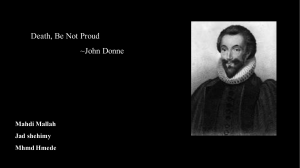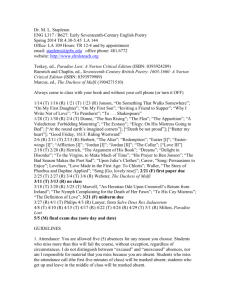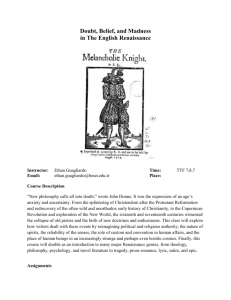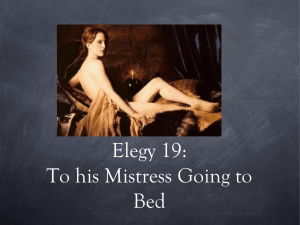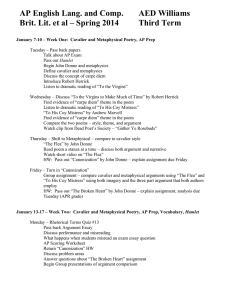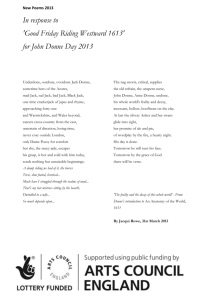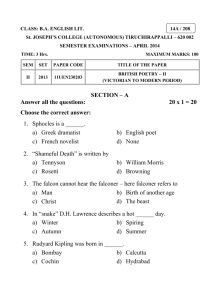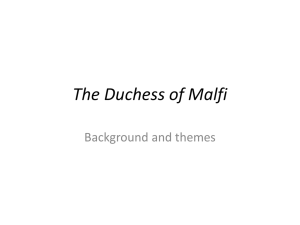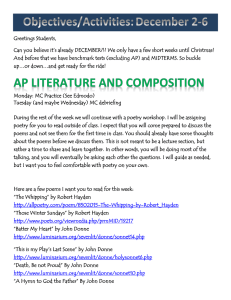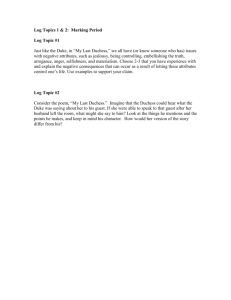File
advertisement
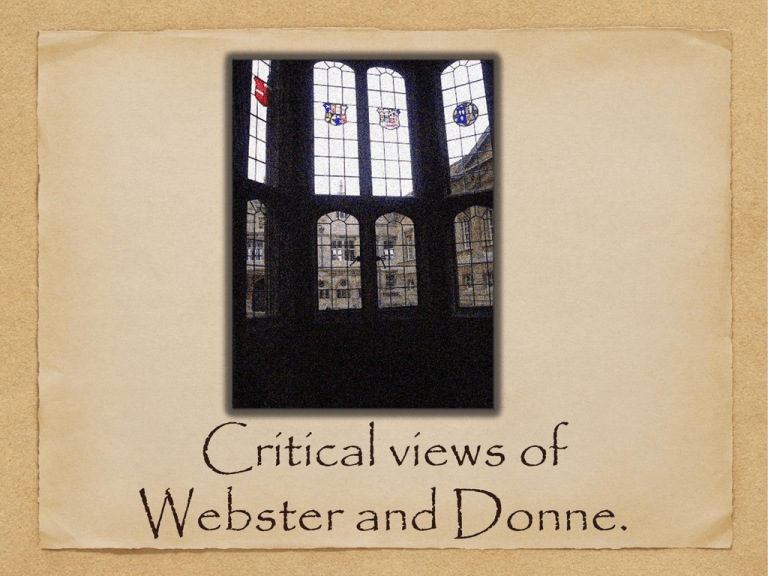
Critical views of Webster and Donne. Great poems read us as much as we read them (WHAuden) What does this poet mean by this comment? Critical perspectives on JOHN DONNE’S POETRY Samuel Taylor Coleridge Admired his: Intellectual complexity Imagery Dramatic situations and rhythmic energy New Criticism (1940s) Meaning is self contained within each poem. Context and biography not significant Authors intention was not relevant ‘Intentional fallacy’ – Wimsatt and Beardsley Psycholanalytical John Carey (1981) Donne, Life Mind and Art. Making sense of the poems through and understanding of the life of the poet. e.g. • • Guilt at his apostasy fuels the religious sonnets. To his mistress going to bed is a masculine reassertion in the face of emasculation of catholic priests Genders Thomas Healy (1992) New Latitudes Imagery is patriarchal (e.g. in To his Mistress Going to bed ) Women are silent and objectified Helen Gardner suggests a focus on contexts and historical accurac y Post-Structuralist Notions of normal reader and enlightening poet are questioned (ref Auden quote) Donne’s attempts to make sense of his world are reflected in our own Emotional and philosophical connection with modern readers. The work as a whole Helen Gardner (1965) Attempts to create some sense of order to his poems and his development as a poet and person. The work as a whole Tilottama Rajan (1982) Deliberately randomized and the sequence not so significant as the moment. We impose structures and beliefs on the art we enagage with. What was Donne doing with his work in his context. De-centred. Critical perspectives on THE DUCHESS OF MALFI TS Eliot (1920) WEBSTER was much possessed by death And saw the skull beneath the skin; And breastless creatures under ground Leaned backward with a lipless grin. Daffodil bulbs instead of balls Stared from the sockets of the eyes! He knew that thought clings round dead limbs Tightening its lusts and luxuries. Rupert Brooke (1916) Webster was a great writer; and the way in which one uses great writers is two-fold. There is the exhilirating way of reading their writing; and there is the essence of the whole man. Leonora Brodwin (1972) Love and harmnoy in a contradictory world. Self sacrifice – all the wealth of Europe is nothing compared to love. Revenge is proved meaningless when moved by justifiable anger Nicholas brooke (1979) ‘evil of preposterous grandeur ….. the logic of definition in death, at horrid laughter at death-in-life’ Tragedy < - > Comedy. Catherine Belsey (1980) Tension when opposites attempt to coalesce, when evil and power fuse, when love encounters betrayal etc Uncertain moment in time (between Medieval -> Restoration) Johm Selzer (1981) More written about play than almost any other non-shakespearean renaissance tragedy Webster daringly suggests a focus on merit rather than class. Badendyck (1985) Woman are the positive construction in the play contrasting with a range of failing men. ‘no denying that the luminous figure of the duchess is perfectly capable of dominance’ The strength of women ‘functions to support their sagging superiors’ Eva Cruz Garcia (1998) Explores class and gender. ‘how effortlessly the language of service becomes the language of love’ The duchess’ class outweighs Antonio being a man Productions You must also make reference to the plays you have seen and some of the reviews of those versions. BBC Production (1972) On Youtube http://www.youtube.com/watch?v=M3NT4lnanTk Sober recognition of anger, confusion and violence, the ridicule or ritual ‘muderously destructive of isolated appetities’ Greenwich Theartre production (2010) ‘Amongst the flattery and paranoia of the Italian Court … set against the backdrop of an escalating European War, the Duchess of malfi is a thrilling portrayal of a family torn apart by lust and lies’ Old Vic Theatre Production (2012) See your sheet with the four contrasting reviews
